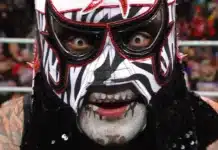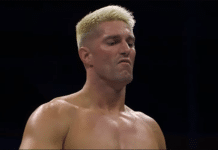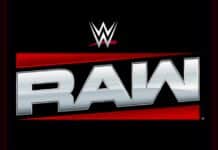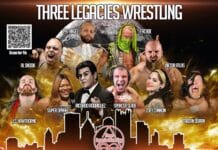As we all continue to struggle with shut down and stay home orders, I decided to push my sanity to the limit for the Wrestlemania challenge series with Wrestlemania IX next on the list. Widely-regarded as one of the worst WM shows of all time, this show took place at one of the lower points at a time when the total industry was in a slump from the steroid scandal of the early-90s. Without any buzz or hype around the entire genre, the booking of this event did it no favors either, as three contests resulted in DQs on what should’ve theoretically been the biggest show of the year. Caesar’s Palace hosted with event in Las Vegas and there was an attempt at a Roman theme, but it all looked rather ridiculous with many at ringside, including Jim Ross, who was working his first WM, wearing togas. The only redeemable portion of the opening segment was Bobby Heenan acting terrified as he rode a camel to the ring, which is a credit to his ability to make almost anything entertaining.
The first match was Shawn Michaels vs. Tatanka for a decent match, but finished was rather flat when there was a delayed DQ because HBK grabbed the referee and stopped his count while Michaels was outside the ring. An often forgotten aspect here is that Tatanka had a nearly two year undefeated streak in the early-90s before his push fell off a cliff by early 1995 and he more or less disappeared from the major wrestling scene for several years after he exited the WWF in early 1996. I’m guessing the DQ finish was a way to keep the title on HBK without Tatanka being defeated to be able to continue his undefeated run. If that was the case, you have to wonder why WWF brass didn’t just book a different match to avoid the conflict so there could be a definitive finish.
The Steiner Brothers vs. The Headshrinkers was the best in-ring match on the card and these two teams probably don’t get enough credit for the quality bouts they had during this era of the WWF. For the Steiners, I would say they probably get overlooked in this WWF run for a few different reasons. Mostly, the industry was in the previously mentioned slump so there just wasn’t as many viewers at the time to take notice of their matches, and they had a relatively brief run. Plus, the majority of their work is so associated with the NWA or WCW that their original stop in the WWF is almost an after thought. The Headshrinkers were simply a victim of circumstances because while they had solid matches on a consistent basis, their gimmick was so cartoonish that it more or less overshadowed their in-ring work. Another reason was that the duo were paired as a team for less than two years before Fatu was eventually repackaged and then later repackaged again. So while The Headshrinkers didn’t have the most extensive run in the WWF, they could undoubtedly go in the ring. The Steiners get the win, but the quality of the show steadily declines throughout the rest of the event.
Next up was Crush vs. Doink, a contest that was the peak cartoonish material in the era. Matt Borne, who we saw be defeated by Ricky Steamboat in a preliminary bout at the first Wrestlemania, is back as a demented clown. Borne had a reputation for being quite an odd bird might’ve been able to get the gimmick over if it was given any chance to get legitimate heat, but the premise of this entire feud was that he used a fake arm to attack Crush a few months earlier. It was just too tacky and the entire presentation was lame. The actual in-ring action was nothing great and the finish that involved a second Doink was another lame aspect to the entire angle. If there was some type of follow-up or some explanation about why there was a second Doink then maybe the finish could’ve made sense. There wasn’t an explanation about who the second Doink was at WM 9, but there would be other Doink performers, as Ray Apollo and a few others used the gimmick after Matt Borne left the company. Let’s not forget the countless low-level indy wrestlers that still use the gimmick today on regional cards that draw less of a crowd than a TNA house show in 2014.
Razor Ramon beat Bob Backlund in a nothing match in just a few minutes. This is a rather odd match-up since Backlund’s style doesn’t seem to work well with Razor’s style, but it was a one-sided contest that was basically just there to waste time. While Backlund had a notable reign as champion a decade before this, theis entire comeback run was questionable. The WWF promoted the “New Generation” as a way to try to distance itself from older stars, but Backlund was a former star that had been out of the spotlight for almost ten years so he didn’t really have any momentum at all by 1993. Granted, if all of this gave a chance for Mr. Backlund to ramble his insane musings on just about everything in the years that followed then maybe it was worth it.
Hulk Hogan, who had been away from wrestling after the negative press of the steroid trail, returned after nearly a year hiatus from the organization. Hulk was teaming with Brutus Beefcake, who had the gimmick of being Hogan’s friend to get a job for the best of his career, against Money Inc. for the tag team titles. This is another scenerio where obviously Hulk wasn’t going to lose a match, but with his future in the company in doubt, it wouldn’t have made scene to put the tag belts on his either so there was an underwhelming DQ after a contest that was average at best.
Lex Luger vs. Mr. Perfect was decent, but even Hennig couldn’t get a great match from Lex on this show. The finish was rather flat, considering that Mr. Perfect’s foot was clearly on the ropes, but the referee continued to count anyway. This was before Lex got the mega push as a discount version of Hulk Hogan, but he had actually been on the roster for over a year. As a way to get out of his WCW deal at the time, Lex signed a World Bodybuilding Federation deal in 1992 with the idea that he would eventually transition to the ring after his Turner contract expired. Lex was involved in a serious motorcycle accident and required surgery that put a plate in his forearm, something that was later used as a part of his gimmick. Lance Storm, one of the brightest minds in the business, recently mentioned on Twitter that Lex had some in-ring ability, particularly before the devastating wreck. It would’ve been interesting to see how his career would’ve progressed if he wasn’t involved in the accident because he didn’t really reach top form against until almost 1997.
All that I will say about the Undertaker/Giant Gonzalez match is that the competitor that portrayed the neanderthal was known as a very nice man. The Undertaker got the win.
Bert Hart vs. Yokozuna for the WWF title was the solid match you’d expect it to be, as it was at a time when Yoko was still at his physical peak, and Bret was just starting to reach his prime. Bret had Yoko in the sharpshooter before Mr. Fuji threw salt in his eyes, allowing the heel to get the victory to claim the championship. As we all know, Hulk Hogan showed up and beat Yoko for the belt in seconds. It’s well-known that Hulk refused to put Bret over and only dropped the title to Yokozuna at King of the Ring that year after goofy interference with a fire ball from a ringside camera. This would be Hulk’s last WM for nine years, as he would jump to WCW in 1994. In retrospect, its completely ridiculous that Hogan took a year away from the company, showed up to win the belt, and then refused to drop it to Bret before he left again. All things considered, I think it would be fair to say that Hulk Hogan did at least as much to damage the business as he did to boost it during his original run in the WWF.
What do you think? Comment below with your thoughts, opinions, feedback and anything else that was raised.
Until next week
-Jim LaMotta
E mail [email protected] | You can follow me on Twitter @jimlamotta







